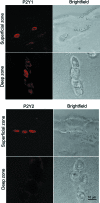Articular chondrocytes express connexin 43 hemichannels and P2 receptors - a putative mechanoreceptor complex involving the primary cilium?
- PMID: 19207989
- PMCID: PMC2667885
- DOI: 10.1111/j.1469-7580.2008.01021.x
Articular chondrocytes express connexin 43 hemichannels and P2 receptors - a putative mechanoreceptor complex involving the primary cilium?
Abstract
Mechanical loading is essential for the health and homeostasis of articular cartilage, although the fundamental mechanotransduction pathways are unclear. Previous studies have demonstrated that cyclic compression up-regulates proteoglycan synthesis via an intracellular Ca(2+) signalling pathway, mediated by the release of ATP. However, the mechanism(s) of ATP release has not been elucidated. The present study examines expression of the putative mechanosensitive ATP-release channel, connexin 43 and whether it is expressed on the chondrocyte primary cilium, which acts as a mechanosensor in a variety of other cell types. In addition the study characterized the expression of a range of purine receptors through which ATP may activate downstream signalling events controlling cell function. Bovine articular chondrocytes were isolated by sequential enzyme digestion and seeded in agarose constructs. To verify the presence of functional hemichannels, Lucifer yellow (LY) uptake into viable cells was quantified following treatment with a hemichannel agonist (EGTA) and antagonist (flufenamic acid). LY uptake was observed in 45% of chondrocytes, increasing to 83% following EGTA treatment (P < 0.001). Treatment with the hemichannel blocker, flufenamic acid, significantly decreased LY uptake to less than 5% with and without EGTA. Immunofluorescence and confocal microscopy confirmed the presence of primary cilia and the expression of connexin 43. Approximately 50% of bovine chondrocyte primary cilia were decorated with connexin 43. Human chondrocytes in situ within cartilage explants also expressed connexin 43 hemichannels. However, expression was confined to the upper 200 microm of the tissue closest to the articular surface. Immunofluorescence revealed the expression of a range of P2X and P2Y receptor subtypes within human articular cartilage. In conclusion, the expression of functional hemichannels by articular chondrocytes may represent the mechanism through which mechanical loading activates ATP release as part of a purinergic mechanotransduction pathway. Furthermore, the expression of connexin 43 on the chondrocyte primary cilium suggests the possible involvement of the cilium in this pathway.
Figures







Similar articles
-
Cyclic loading opens hemichannels to release ATP as part of a chondrocyte mechanotransduction pathway.J Orthop Res. 2010 Apr;28(4):510-5. doi: 10.1002/jor.21025. J Orthop Res. 2010. PMID: 19890993
-
Primary cilia disassembly down-regulates mechanosensitive hedgehog signalling: a feedback mechanism controlling ADAMTS-5 expression in chondrocytes.Osteoarthritis Cartilage. 2014 Mar;22(3):490-8. doi: 10.1016/j.joca.2013.12.016. Epub 2014 Jan 21. Osteoarthritis Cartilage. 2014. PMID: 24457103 Free PMC article.
-
Activation of chondrocytes calcium signalling by dynamic compression is independent of number of cycles.Arch Biochem Biophys. 2005 Dec 1;444(1):45-51. doi: 10.1016/j.abb.2005.09.015. Epub 2005 Oct 25. Arch Biochem Biophys. 2005. PMID: 16289021
-
The chondrocyte primary cilium.Osteoarthritis Cartilage. 2014 Aug;22(8):1071-6. doi: 10.1016/j.joca.2014.05.011. Epub 2014 May 29. Osteoarthritis Cartilage. 2014. PMID: 24879961 Review.
-
Primary cilium-mediated mechanotransduction in cartilage chondrocytes.Exp Biol Med (Maywood). 2023 Aug;248(15):1279-1287. doi: 10.1177/15353702231199079. Epub 2023 Oct 28. Exp Biol Med (Maywood). 2023. PMID: 37897221 Free PMC article. Review.
Cited by
-
Extracellular Nucleotides Selectively Induce Migration of Chondrocytes and Expression of Type II Collagen.Int J Mol Sci. 2020 Jul 23;21(15):5227. doi: 10.3390/ijms21155227. Int J Mol Sci. 2020. PMID: 32718031 Free PMC article.
-
STRAINS: A big data method for classifying cellular response to stimuli at the tissue scale.PLoS One. 2022 Dec 8;17(12):e0278626. doi: 10.1371/journal.pone.0278626. eCollection 2022. PLoS One. 2022. PMID: 36480531 Free PMC article.
-
Membrane channel gene expression in human costal and articular chondrocytes.Organogenesis. 2016 Apr 2;12(2):94-107. doi: 10.1080/15476278.2016.1181238. Epub 2016 Apr 26. Organogenesis. 2016. PMID: 27116676 Free PMC article.
-
Spontaneous calcium signaling of cartilage cells: from spatiotemporal features to biophysical modeling.FASEB J. 2019 Apr;33(4):4675-4687. doi: 10.1096/fj.201801460R. Epub 2019 Jan 2. FASEB J. 2019. PMID: 30601690 Free PMC article.
-
Primary cilia and coordination of receptor tyrosine kinase (RTK) signalling.J Pathol. 2012 Jan;226(2):172-84. doi: 10.1002/path.3004. Epub 2011 Nov 21. J Pathol. 2012. PMID: 21956154 Free PMC article. Review.
References
-
- Bao L, Sachs F, Dahl G. Connexins are mechanosensitive. Am J Physiol Cell Physiol. 2004;287:C1389–C1395. - PubMed
-
- Bodin P, Burnstock G. Purinergic signalling: ATP release. Neurochem Res. 2001;26(8–9):959–969. - PubMed
-
- Brown CJ, Caswell AM, Rahman S, Russell RG, Buttle DJ. Proteoglycan breakdown from bovine nasal cartilage is increased, and from articular cartilage is decreased, by extracellular ATP. Biochim Biophys Acta. 1997;1362(2–3):208–220. - PubMed
-
- Caswell AM, Russell RG. Identification of ecto-nucleoside triphosphate pyrophosphatase in human articular chondrocytes in monolayer culture. Biochim Biophys Acta. 1985;847:40–47. - PubMed
-
- Caswell AM, Leong WS, Russell RG. Evidence for the presence of P2-purinoceptors at the surface of human articular chondrocytes in monolayer culture. Biochim Biophys Acta. 1991;1074:151–158. - PubMed
Publication types
MeSH terms
Substances
LinkOut - more resources
Full Text Sources
Miscellaneous

